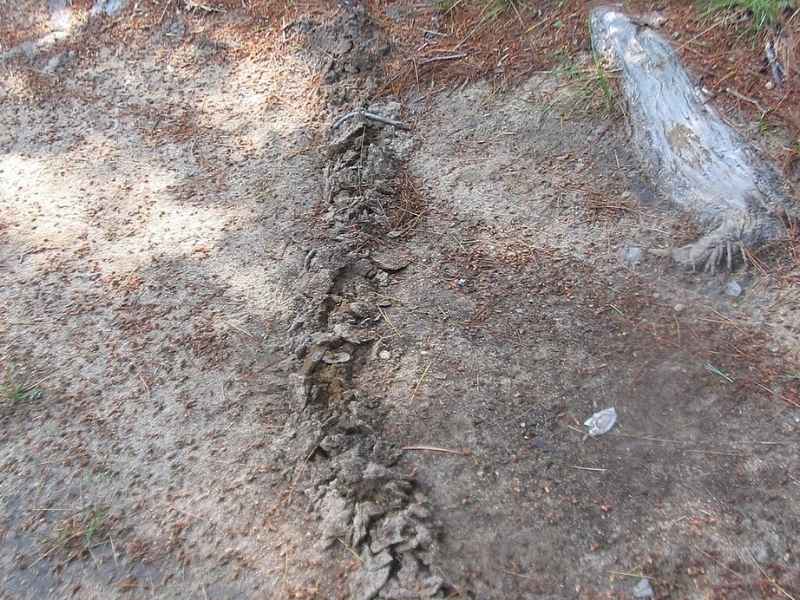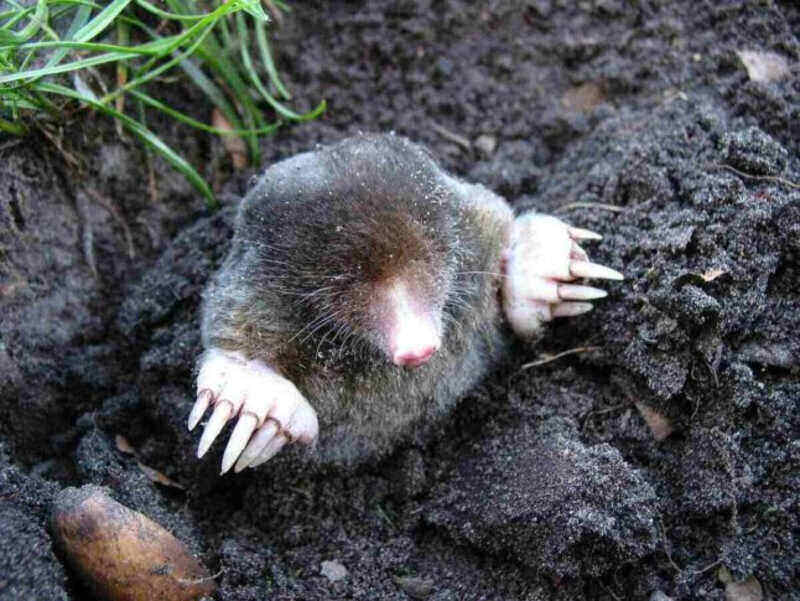
The best ways to get rid of moles in your yard are trapping, using bait, and spreading mole repellents. The faster you act, the easier it is to remove these little critters.
Moles control lawn pests and aerate the soil, but their digging can harm plants and create messy ridges and unsightly molehills in your landscape. When the lawn gradually mirrors a battlefield, it’s time to relocate the tricky diggers. This article covers the best mole control methods to use and the strategies that might not be worth your time.
How to Identify Active Mole Tunnels

Look for longer, straighter ridges that moles keep on rebuilding when you pierce or flatten them.
Looking for long, almost straight ridges with light curves. These are tunnels that moles use multiple times and provide the best chances to trap a mole. Avoid short, twisting ridges close to each other – these are feeding tunnels that moles only use once or twice.
To check if the traveling tunnels are active:
- Flatten the ridges by walking on them or pulling a lawn roller over the grass, mulch, or soil.
- Or, make a hole in each tunnel using a stick or a finger.
- Return the next day and check the ridges. Where the moles have been, the ridges are back, and the holes are fixed.
Those are the active tunnels.
Now that you’ve identified active mole tunnels, you can try some of these control methods.
Spread Some Gummy Baits
Worm and grub-shaped gummy baits can kill moles 12 to 24 hours after ingestion.
Poisoned baits are a good option if you’re looking for an easy way to kill the moles in your lawn. Moles die in their burrows 12 to 24 hours after ingestion, so you don’t have to touch or relocate the animal.
What are the best mole baits? Gummy baits looking like worms or grubs – mole’s favorite snack – are the most effective options. Here are a few examples available for purchase online:
Moles are not rodents, so classical rodent baits (seeds, pallets, etc.) do not attract them.
How to use mole baits:
1. Put on gloves when you handle bait to avoid getting poison on your skin and leaving your scent on the bait.
2. Choose 3 to 4 active tunnels across the lawn.
3. Poke a small hole into the ridge with a stick.
4. Place a single piece of bait inside each tunnel.
5. Cover the hole with dirt and grass.
6. Wait for a few days.
7. Repeat these steps if molehills and ridges still appear.
Pro tip: The best time to place mole bait is after a light rain or irrigation. Moles hunt when the soil is damp.
Trap and Release
Traps installed correctly along active tunneling can help you get rid of moles fast and permanently.
There are several types of mole traps. Humane or live catch traps are often metal cages or plastic cylinders that allow moles to enter but prevent them from exiting.
Note: Trapped moles need to be relocated to a new habitat. Check your local regulations regarding wildlife relocation. To avoid having to do it yourself, you can always call a local wildlife relocation service.
These traps require digging and are often installed in the tunnel below a freshly built molehill (one that recently appeared on your lawn). Here’s how to install a humane trap:
- Shovel the molehill dirt away and dig down until you see the entry into a horizontal tunnel.
- Place the trap with the opening toward the tunnel entry.
- Cover back with dirt.
- Place a bucket on top to make sure no light creeps in.
- Check every few hours, especially if it’s summer. Trapped moles can die of heat and dehydration.
Watch the video below to see the step-by-step installation of humane traps.
Among the traps that kill the moles instead of capturing them, scissor traps and harpoon traps are the most effective and easy to use.
How to Install Scissor Traps
A scissor trap, also known as Victor out-of-sight mole trap, looks like two scissors stuck together by a metal rod. To install it:
- Press the handle to open the scissors. Engage the latch to keep the trap open while you install it.
- Push the trap into the ground over the tunnel so the two scissors straddle it.
- Press the soil beneath the trigger with your finger so a small dirt wall blocks the tunnel.
- Release the latch.
- Place a bucket over the trap. This will remind you to check the trap daily and prevent light from entering the tunnel.
The video below shows a detailed explanation from Dr. Drew Ricketts at Kansas State University.
How to Install Harpoon Traps
Also known as plunger traps, harpoon traps look like tall, skinny frames with sharp spikes pointing down and a strong spring that pushes the spikes when the trigger is activated. To install it:
- Pull the handle up to raise the spikes and arm the spring.
- Press the ridge with your feet to push dirt inside the tunnel and create an obstacle.
- Push the trap into the ground above the pressed soil with the stakes and trigger standing on the soil.
- Place a bucket over the trap. This will remind you to check the trap daily and prevent light from entering the tunnel.
See more details on how to install a harpoon trap in the video below:
Use Mole Repellents
Castor oil-based repellants can drive moles off your property but are a temporary solution.
Castor oil is supposed to drive away moles with its foul smell. The oil also triggers digestive problems if it gets on the insects moles eat or the mole’s fur, which they clean by licking. You’ll find mole repellants in granular and liquid form and as round pellets imbibed with repellant.
- Granular products are applied with a spreader and lightly watered afterward. They last the longest (up to three months).
- Liquid products require dilution following the label directions. You apply the diluted solution using a garden sprayer and a hose.
- Spray repellants are ready-to-use solutions. You attach the container to a garden hose and start spreading the repellant.
- Round pellets, about the size of a golf ball. You place these in a shallow hole, cover them with dirt, and then water lightly. They dissolve in time. Look for pellets rich in castor oil. It is more effective than other essential oils used in these repellants (e.g., mint, garlic, rosemary).
How to spread mole repellents on your property:
- Identify active tunnels.
- Plan a way out for the moles; otherwise, they’ll remain in your yard.
- Put on some gloves.
- Start the application with the area where you spot active tunnels. Treat another section of the lawn every day going toward the exit area.
- Repeat the application after a month or two (check product instructions). Otherwise, moles might return.
Mole repellents with castor oil are usually safe for pets and children, but it’s a good idea to be careful when applying. Keep them off the lawn while you spray for moles.
Note: You can make a DIY castor oil repellent by mixing 6 ounces of 100% castor oil with 2 tablespoons of dish soap and 1 gallon of water. Dilute 1 ounce of solution into 1 gallon of water and use it on the lawn.
Dig a Trench
Trenches about 2 feet deep filled with gravel, rocks, or fence mesh can stop moles from entering small planted areas.
This method is costly and time-consuming, so most homeowners only use it to protect valuable sites such as vegetable gardens or ornamentals. However, protective tranches are long-lasting and also keep the plants safe from gophers, rabbits, mice, and other garden critters.
Here’s how to dig a trench to keep moles away:
- Dig a trench 2 inches wide and about 2 feet deep around the area you want to keep moles out of.
- Fill it with rocks or gravel – moles can’t dig through hard material.
- Cover the trench with soil.
You can seal the area by inserting a wire fence into the trench. Experts from the University of Nebraska-Lincoln recommend aluminum sheeting or ¼-inch mesh galvanized hardware cloth. “Bury to a depth of 24 to 30 inches and allow 6 inches to extend above the ground surface.”
Bending out the base of the fence about 4 inches at a 90-degree angle can discourage moles from digging deeper.
Note: Trenches are not bulletproof. Stubborn or very hungry moles might dig deeper.
Reduce the Food Source
Reducing the food source can make your yard less attractive to moles, but it won’t banish them from your property alone. You also need traps, baits, or repellants.
This strategy is less effective because the moles’ diet is 70% to 90% earthworms, which are essential for soil health. Reducing the earthworms in the soil enough to make the moles leave might be more damaging for the lawn than the moles.
However, you can control other lawn bugs moles like to eat (white grubs, armyworms, ants, mole crickets, snails, slugs, Japanese beetles) and turn your yard from a rich buffet into a poorly supplied supermarket.
Alternative Methods

Mole-Deterrent Plants
Plants like daffodils, marigolds, alliums (garlic, shallots), caster oil beans, and Euphorbia lathyris (mole plant) are said to deter moles either because of their odor or because they repel insects and reduce their food source. However, there is no scientific evidence to support this.
Scare Tactics (ultrasonic devices, pinwheels, vibration stakes)
Lawn moles are difficult to frighten because they are already exposed to heavy lawn equipment, sprinklers, and people traffic. When these devices work, the effect is only temporary until moles get used to them.
Mole Predators
Dogs and cats can effectively dig out and catch moles, but they might tear the yard apart. You can also install high perches, birdbaths, and bird feeders to attract hawks, owls, and other natural mole predators.
Fumigants
Using fumigants to kill moles is illegal in some states, and even where allowed, they have little effect outdoors, where the gas is easily dispersed.
“Moles naturally exist in a low oxygen environment and can easily wait for the fumes to dissipate in the tunnels,” says Rebecca McPeake, professor and extension wildlife specialist at the University of Arkansas.
Mothballs
Mothballs are a popular folk remedy for moles and other garden pests, but they are not your best choice. They are less effective and more toxic than castor oil repellants.
These insecticides kill cloth moths and other fabric insects. They contain high amounts of naphthalene or paradichlorobenzene – dangerous chemicals that release toxic gases. That’s why mothballs are regulated by the United States Environmental Protection Agency (EPA) and should only be used as the product label indicates.
Typically, you place mothballs in tightly closed containers with the infested clothing to concentrate the gases and avoid inhaling them. When used out in the open, mothballs are less effective and can accidentally harm people, pets, or wildlife that may touch, eat, or breathe in their vapors.
Mothballs are also harmful to the environment. Paradichlorobenzene persists for up to 31 days, binds to the soil, and can end up in plants and groundwater.
How to Prevent Moles From Returning
You don’t want a mole hole leading to a mountain of a problem. Once you have said goodbye, you’ll want to keep them out. To prevent moles from returning:
- Avoid thick mulch and exposed compost piles: These are magnets for moles. If you’re making your own compost, try using enclosed bins.
- Correct drainage issues: If you find areas where water collects, it may be time to level your lawn. It will save damage in the long run and won’t attract moles to the soft ground and bugs.
- Keep lawn bugs under control: Grubs, ants, armyworms, and other lawn pests make your yard more attractive for moles. Use milky spores, beneficial nematodes, and insecticides to reduce their number.
- Avoid overwatering: Moles prefer moist soil, which is easier to dig and attracts insects and earthworms.
When to Hire a Professional
For extensive mole problems, hire a pest control professional. LawnStarter can connect you with the best pros in your area. Not only can they help you get rid of moles, but they can also take care of any pest that burdens your lawn.
Worried about the mole mess? LawnStarter pros can clean the yard, fill in the trenches, reseed the brown patches, and trim the turf to a perfect velvet look. They’ll repair your lawn in a jiffy and keep it spotless year-round.
Sources:
- Purdue University. How do I get rid of moles in my lawn? https://ag.purdue.edu/department/btny/ppdl/potw-dept-folder/2023/moles-in-lawn.html
- McPeake, R. (2014). Controlling the Eastern Mole. University of Arkansas. https://www.uaex.uada.edu/publications/pdf/FSA-9095.pdf
Main Image Credit: Kenneth Catania, Vanderbilt University / Wikimedia Commons / CC BY-SA